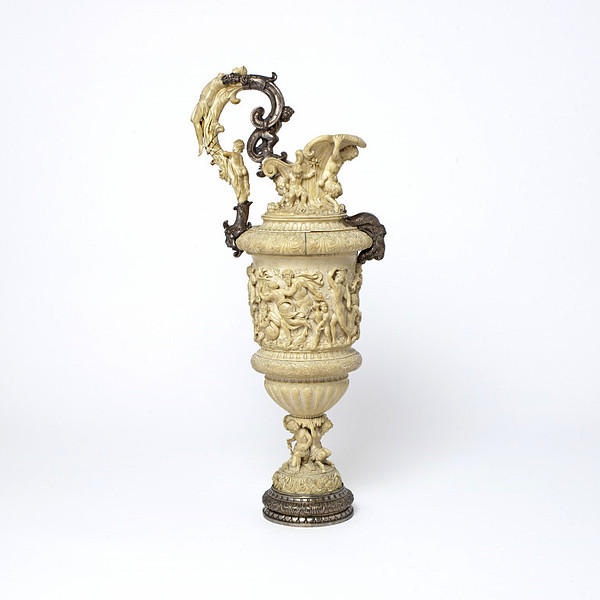A Finely Carved Ivory and Silver-Mounted Ewer and Charger
German, circa 1860
Ewer: 20 ¾ in (52 cm) high
Charger: 19 ¾ in (119 cm) diameter
Provenance
Private Collection, Wiltshire, England
Literature
Wendell Stanton Howard, The George A. Hearn Collection of Carved Ivories, 1908, p.215, pl.178
Charger: 19 ¾ in (119 cm) diameter
Provenance
Private Collection, Wiltshire, England
Literature
Wendell Stanton Howard, The George A. Hearn Collection of Carved Ivories, 1908, p.215, pl.178
The 17th century saw a change in art from the religious to the secular. Public taste embraced the classical with romanticised nudes and hedonistic subjects. The art of Rubens and Bernini influenced those working in ivory, and the classical iconography of the triumph of Bacchus with dancing nymphs and frolicking fauns, together with putti and bacchante processions became de rigueur. Once carved, these pieces were often mounted with silver in the prominent metalwork centres of Augsburg and Nuremburg.
A ewer and charger like this celebrates the aesthetic rather than the practical. The ewer's everted lip is supported by two bacchantes flanking a mask. The ovoid body of the ewer has three bands, one with reclining bacchantes among fruit swags, the central band with Bacchus's leopard-drawn chariot followed by a procession of bacchantes, satyrs and putti, and finally the lower band with winged female busts and grotesque masks. The scrolling handle has a putto sitting on the shoulders of a bacchante, while three winged and hoofed females sit perched upon a domed foot with masks and silver mountings. The circular charger has a central roundel depicting a reclining Venus and Cupid. The border around the roundel is interspersed with silver mounts and depicts a continuous procession of bacchanal merry-making. The popularity of this form was due in large part to the German artist Michael Maucher.
A ewer of similar style is held in the Victoria and Albert Museum.
A ewer and charger like this celebrates the aesthetic rather than the practical. The ewer's everted lip is supported by two bacchantes flanking a mask. The ovoid body of the ewer has three bands, one with reclining bacchantes among fruit swags, the central band with Bacchus's leopard-drawn chariot followed by a procession of bacchantes, satyrs and putti, and finally the lower band with winged female busts and grotesque masks. The scrolling handle has a putto sitting on the shoulders of a bacchante, while three winged and hoofed females sit perched upon a domed foot with masks and silver mountings. The circular charger has a central roundel depicting a reclining Venus and Cupid. The border around the roundel is interspersed with silver mounts and depicts a continuous procession of bacchanal merry-making. The popularity of this form was due in large part to the German artist Michael Maucher.
A ewer of similar style is held in the Victoria and Albert Museum.
























